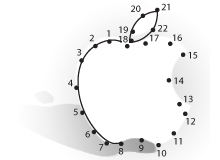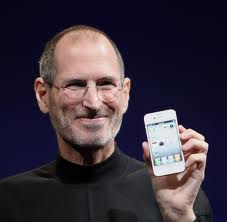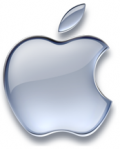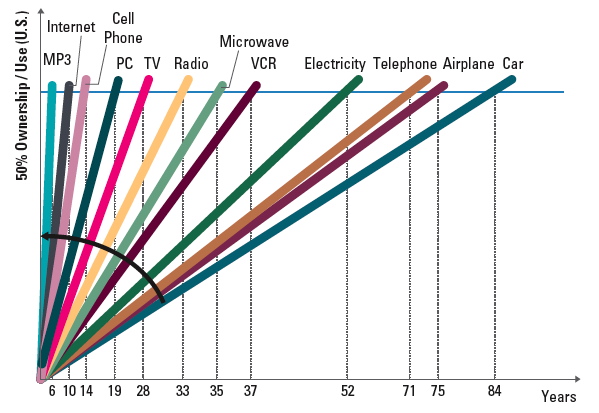

Vertical Integration Works for Apple—But It Won?t for Everyone
Wharton professors explain why Apple integrated model of designing both hardware and software may not work for other companies. Knowledge@Wharton reports:
Google recently acquired mobile device maker Motorola Mobility and will soon manufacture smartphones and television set-top boxes. Amazon’s Kindle Fire tablet represents its bridge between hardware and e-commerce. Oracle bought Sun Microsystems and now champions engineered systems (integrated hardware and software devices). And even long-standing software giant Microsoft now makes hardware for its Xbox gaming system. Technology titans are increasingly looking like vertically integrated conglomerates largely in an attempt to emulate the success of Apple.Vertical integration dictates that one company controls the end product as well as its component parts. In technology, Apple for 35 years has championed a vertical model, which features an integrated hardware and software approach. For instance, the iPhone and iPad have hardware and software designed by Apple, which also designed its own processors for the devices. This integration has allowed Apple to set the pace for mobile computing. “Despite the benefits of specialization, it can make sense to have everything under one roof,” says Wharton management professor David Hsu.
Categories: Strategy Implementation - 782 | Case Studies | Apple | Topics | Congruence Model |

JetBlue to Review Procedures After Pilot Meltdown: CEO
A pilot on a JetBlue flight had a complete mental meltdown. The co-pilot had to lock him out the cockpit and passengers had wrestle him down and constraint him with their belts. If you are the CEO, what you want to know know is whether this was an isolated incident (which can always happen) or whether your HR systems are not properly design. For this reason it makes sense that the CEO ordered a review. Read full story here.
Categories: Strategy Implementation - 782 | Topics | Congruence Model |



1985 Steve Jobs is fired, Bill Gates sends letter to John Sculley urging him to license Mac OS
Neal Pancholi drew my attention to this interesting letter by Bill Gates. It shows that Gates in 1985 was sill open to making his fortune my selling Mac software rather than dominating the next generation OS.
To: John Sculley, Jean Louis Gassée
From: Bill Gates, Jeff Raikes
Date: June 25, 1985
Re: Apple Licensing of Mac Technologycc: Jon Shirley
Background
Apple’s stated position in personal computers is innovative technology leader. This position implies that Apple must create a standard on new, advanced technology. They must establish a “revolutionary” architecture, which necessarily implies new development incompatible with existing architectures.
Apple must make Macintosh a standard. But no personal computer company, not even IBM, can create a standard without independent support. Even though Apple realized this, they have not been able to gain the independent support required to be perceived as a standard.
Categories: Strategy Implementation - 782 | Case Studies | Apple | Topics | Positioning Strategy First |


What it takes to do a corporate turnaround
John John Baldoni writes on CBS.com.
Enter Sergio Marchionne. With Fiat was on the brink of solvency in 2004, Marchionne was named CEO and completely revamped the enterprise. He would later do the same at Chrysler. As Clark writes: “Marchionne’s unusual ability is that he can see what actually needs to be done, and then cajoles and goads his flat management structure of dozens of direct reports in weekend meetings to achieve the goal.” “Marchionne doesn’t let go,” A UBS analyst adds. “That’s what his strength is. He is good at strategy and at execution.” Under Marchionne, both Fiat and Chrysler have turned the corner (at least for now).
The balance between vision and execution is akin to right- and left-brain thinking. A visionary thinks about what can happen. He or she has a highly specific vision of the future—and not simply as a set of desired outcomes, but rather in terms of what must occur to produce those outcomes. By contrast, executing the vision requires putting the right people in place and providing them with the necessary resources to succeed. It also means holding people’s feet to the fire. Marchionne is known for firing people who aren’t up to the task. It’s never pleasant, but it is imperative.
Read Full Article on CBSnews.com
Categories: Strategic Management 4 | Topics | Turnarounds | Strategy Implementation - 782 | Topics | Management Process |


How Sheryl Sandberg (COO of Facebook) helps women to network
When Facebook goes public Sheryl Sanberg will be a very wealth women. She wants to serve as a role model for other women in business and is actively trying to help them. Here is how she facilitates networking.
If Silicon Valley men bond in venture capital conference rooms or on weekend bike trips, Ms. Sandberg has been building an alternate networking group of Silicon Valley women. For about seven years, since she was a Google executive, she has held catered monthly dinner parties at her home for a group of several dozen women. Guest speakers have included the feminist and author Gloria Steinem; Steve Ballmer, the C.E.O. of Microsoft; and Mayor Michael R. Bloomberg of New York, according to three people who have attended the dinners but spoke on condition that they not be identified out of respect for Ms. Sandberg’s privacy. Ms. Sandberg recently invited Senator Claire McCaskill of Missouri to attend as a speaker. “I expected to see a lot of women in St. John suits and expensive purses and was pleasantly surprised when it was anything but that,” Senator McCaskill said. “Women had been included that were in the infancy of their careers, her kids were running around, it was very low key. It was clear that she’s the kind of role model that young women are looking for, especially in the tech sector.”
Source: NY Times
There is also an excellent long profile of Sandberg in the New Yorker (2011). A Woman’s Place-Can Sheryl Sandberg upend Silicon Valley’s male-dominated culture?
Categories: Strategy Implementation - 782 | Topics | Self & Career Development |

Steve Job trying to build NeXT
This film, following Steve Jobs in the early days of next, show him both as a visionary and motivator but from minutes 15 to 20 as poor manager who did not ensure that deadlines were met by sticking to agreements about product features.
Categories: Strategy Implementation - 782 | Case Studies | Apple | Topics | Leadership Style |

Overview of the Management System of Southwest and the Leadership Style of Herb Kellerher (44 min)
It is useful to compares this to Jack Welsh and Steve Jobs in his later years (1997-2011) when he was much more focused on creating products that would sell in large numbers.
Categories: Strategy Implementation - 782 | Case Studies | Southwest | Topics | Congruence Model | Leadership Style | Positioning Strategy First |


Blackberry has difficulty adjusting its strategy quickly to a changed environment
The leaders of Blackberry did not realized that the iPhone was a real threat until their marketshare had been decimated. The smartphone market is moving so fast that leaders quickly quickly becomes losers because the cannot change quickly enough. The NY Times reports today:
At the time the first iPhone appeared in 2008, RIM had successfully moved the BlackBerry into the broad consumer market from its base of government and corporate customers. But the company was totally unprepared for the popularity of a phone that lacked a physical keyboard and ran thousands of applications — in effect a versatile Web-connected handheld computer.
RIM’s co-chief executives were initially dismissive of the challenge from Apple, and Mr. Balsillie boasted that the iPhone would enhance RIM’s fortunes by increasing awareness of smartphones.
But the iPhone introduced two broad changes to the smartphone market that had severe consequences for RIM and other phone makers, including Nokia.
The iPhone and its apps shifted the emphasis from hardware to software. Then, the iPhone’s popularity led corporate information technology departments, which once allowed only BlackBerrys to connect to their e-mail networks, to support employees’ iPhones. The arrival of Android-based phones from a variety of manufacturers only compounded RIM’s woes.
Read full story here.
Related: The New Yorker on BlackBerry’s troubles.
Click on “More” for an video message of the new CEO to employees.
Categories: Strategic Management 4 | Topics | Turnarounds | Strategy Implementation - 782 | Case Studies | Apple | RIM | Topics | Positioning Strategy First |

Can American Society Demand that Apple create more factory jobs in the U.S.?
Now that Apple has become at least temporarily the most valuable company in the U.S and the American workers are hurting it is not surprising that the press is focusing on Apple outsourcing all it manufacturing overseas. This article brings into focus the question that we will discuss in session 4 of the class, namely what is or should be the fundamental objective of a particular firm. Who should decided this? It is possible to have many different fundamental objectives. If “yes”, how and who decides what trade-offs are to be be made.
Apple, America, and a Squeezed Middle Class: How U.S. Lost Out on iPhone Work in NY Times.
Categories: Strategy Implementation - 782 | Case Studies | Apple | Topics | Fundamental Objective |
Topics

